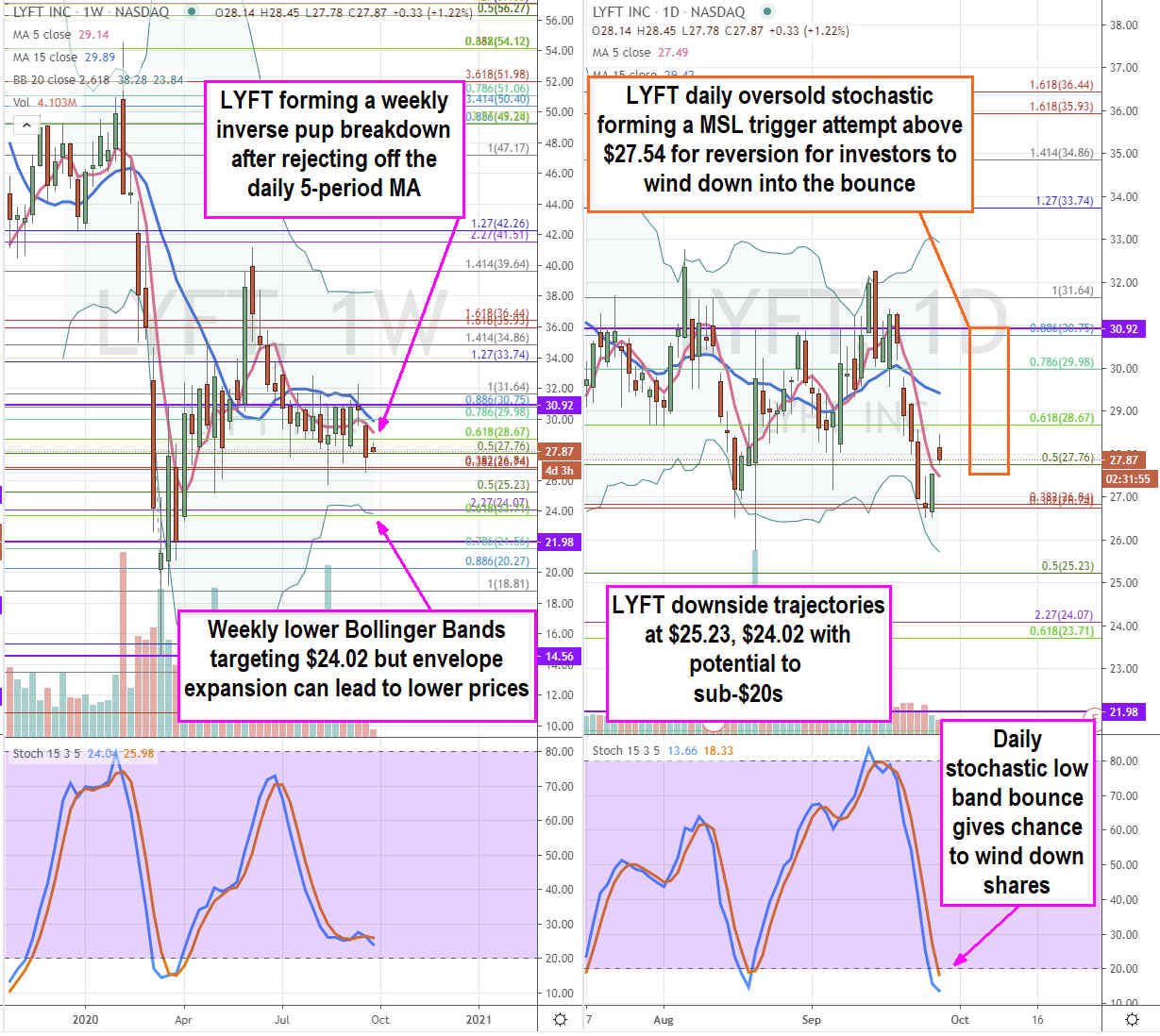
Rideshare operator Lyft Inc. (NASDAQ: LYFT) shares have been underperforming benchmark S&P 500 index (NYSEARCA: SPY). The markets as exposing the so-called “path to profitability” as being more of a highway to hell as its deteriorating operating model gets further ravaged by the effects of COVID-19, loss of market share to the competition, an unraveling network, mismanagement and AB5 legislation. Growth has stagnated and the Company has resorted to using sequential growth metrics and continues to leave out critical booking numbers that even its chief competitor Uber Technologies (NASDAQ: UBER) includes in its earnings releases. Investors may want to use opportunistic exit levels to wind down exposure as the inevitable reality sets in with each quarter that Lyft more likely resembles a glorified taxi (plus bikes and scooters) dispatcher than a disruptive hyper-growth digital innovator.
Q2 FY 2020 Earnings Release
On Aug 12, 2020, Lyft released its second-quarter fiscal 2020 results for the quarter ending June 2020. The Company reported an adjust earnings-per-share (EPS) loss of (-$0.86) excluding non-recurring items versus consensus analyst estimates for a loss of (-$0.97), beating estimates by $0.11. Revenues fell (-60.9%) year-over-year (YoY) to $349.44 million falling shy of the $349.44 million consensus analyst estimates. Active riders fell (-60%) YoY to 21.8 million. Revenue per active rider (RPAR) dropped to $39.77. The Company looks to achieve $300 million of annualized fixed cost savings by end of 2020 which should enable it to reach adjusted EBITDA profitability with 20% to 25% fewer rides for their Q4 2021 target.
California’s Proposition 22
The biggest immediate catalyst for rideshare companies is the upcoming ruling on Proposition 22 which seeks to classify app-based drivers as independent contractors and not employees as stipulated by California’s AB5 law. Lyft, Uber and DoorDash have raised an estimated $180 million in its campaign to convince voters to say no to Proposition 22. Both Lyft and Uber have threatened to pull its services if AB5 continues to exist as is. This is a case of cutting off the nose to spite the face, but in Lyft’s case, it’s more like cutting off a leg to spite the toes since California is its largest market. Uber is diversified with its revenue sources both domestically and internationally. While Uber can find creative new ways to lose money, they can still dangle the carrot of growth, innovation and upside, whereas Lyft is just a transport company limited to the U.S. amidst shrinking market share, network and margins. Other states have caught wind of driver complaints as well as opportunities to siphon more tax revenues from rideshare companies. For example, Seattle is set to impose a minimum wage for rideshare drivers. If Lyft and Uber leave California, the California Taxi Commission is preparing plans to enable taxi companies to onboard app-based drivers to operate similar to rideshare by eliminating vehicle caps and adjusting guidelines. This further dilutes the after-effects that Lyft and Uber are threatening with the passing of Proposition 22.
No Diversification
Lyft’s misguided management didn’t anticipate their plan of focusing strictly on rideshare also cubby-holed the company into a one-trick pony. The lack of expansion beyond the U.S. also caps its upside growth. The electric scooters and e-bikes are so “non-material”, they don’t bother to separate them in the revenue disclosures nor include booking figures. The Company relies on independent drivers and passengers who can switch to take another rideshare or transport service on a dime. This completely dilutes the ‘network effect’ for Lyft’s platform.
Valuation Reality
As a transportation company, Lyft’s valuation can’t be judged on a P/E since there are no profits to be found. Additionally, the accounting gimmicks including “adjusted” everything and contribution margin and lack of revenue channel breakdown or booking numbers leaves just the growth comps, which are questionable without booking figures. The price-sales (P/S) is at 2.48 whereas the transportation sector averages a trailing P/S under 1X. Unless it’s a well-run machine like Union Pacific (NYSE: UNP) which can command a 6X PS, but they also have a solid operating model and “real” profits. Investors may want to unwind exposure on Lyft into the reversion bounces. 
LYFT Price Trajectories
Using the rifle charts on the weekly and daily time frames provides a near-term view of the landscape for LYFT stock. The weekly rifle chart triggered a stochastic mini pup on the market structure low (MSL) buy above $30.92, which has turned into a resistance. The weekly stochastic lost momentum and crossed back down after rejecting off the 5-period moving average (MA) creeping lower near the $28.67 Fibonacci (fib) level. The daily stochastic fell through the 20-band oversold level which is setting up a potential bounce on the 20-band crossover back up as the daily rifle chart forms a MSL trigger above $27.54. This can provide opportunistic exit levels into the updraft at $27.76 fib, $28.67 weekly 5-period MA overlapping fib, $29.98 fib and $30.92 weekly MSL trigger and fib. However, if the $26.94 fib breakdown, then a daily mini inverse pup could rug pull shares back down to the $25.23 and $24.02 to $23.73 fib. Lyft shares usually move with Uber so it’s best to track price action together.
Companies in This Article: